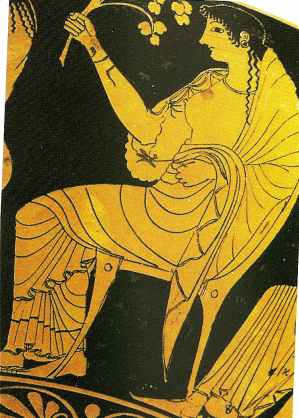Hestia, the Virgin Hearth Goddess
Being the ancient greek hearth goddess, Hestia had a very distinguished place in the ancient greek religion, because the hearth itself took center stage in the lives of ancient greeks. The hearth was not only vital to daily activities and needs, but served a religious purpose as well. On each hearth, ancient greeks built a small altar for worshipping all the deities which protected their home. Thus, the hearth was personified into a deity, which protected and sheltered family life from physical threat and in addition, safeguarded the adherence to high moral values. The protection offered by the hearth goddess, however, was not limited to the family circle in the strict sense, but also it extended to the city life. In ancient Greece, each city or settlement, had a central hearth, called Prytaneio, where a fire burned continuously in honor of the goddess. This is where foreign emissaries, distinguished visitors and benefactors were received and granted hospitality. When a city founded a colony, the settlers took with them a torch that was lit from the sacred flame of their prytaneio. This torch was then used to light the new hearth in their new homeland.
Cosmic interpretations through the mythsAccording to ancient mythic accounts, the gods Poseidon and Apollo sought to unite with Hestia. However, the goddess rejected their request, having vowed to protect her virginity.In appreciation for her steadfastness, her heavenly father Zeus rewarded her by installing her in the middle of the home where the hearth is, thus putting her in the most prominent place of the ancient greek home. In this context, the hearth goddess is identified with Gaia (Earth), since in ancient times it was believed that Earth was in the center of the universe. Indeed, the notion of the goddess being pure and virgin is in line with the notion that ancient Greeks had of their gods, in relation to their cosmos, as they perceived it: The sun (Apollo) sees Gaia (Hestia) but does not unite with her; the sea (Poseidon) embraces her, but does not cover her.
The goddess in ancient greek artIn ancient geek literature, there is unfortunately scarce evidence about the way that the greek hearth goddess was portrayed in art. Archaelogists have yet to unearth any findings which would overturn the prevalent theory that the goddess's rather vague personality did not inspire many of the ancient Greek artists.There are, however, some unconfirmed references to a statue by Glaucus (fifth century B.C), a work by Scopas (fourth century B.C), as well as the existence of statues of Hestia in the antechamber of the temple of Zeus at Olympia, at Pherae in Achaia, and at the Prytaneion in Athens. The famous relief of the goddess dressed in a simple garment and her right hand raised towards the sky, has been dated to Roman times and is often attributed to either Demeter or her daughter, Persephone. It is worth noting that Roman paid special tribute to Hestia, whom they called Vesta.
Return from Hestia to Greek Pantheon
|
||
Resource MaterialClassroom MaterialMovies,DVDs, Games and BooksAbout the SiteYour Stories |
||
|
|
||







